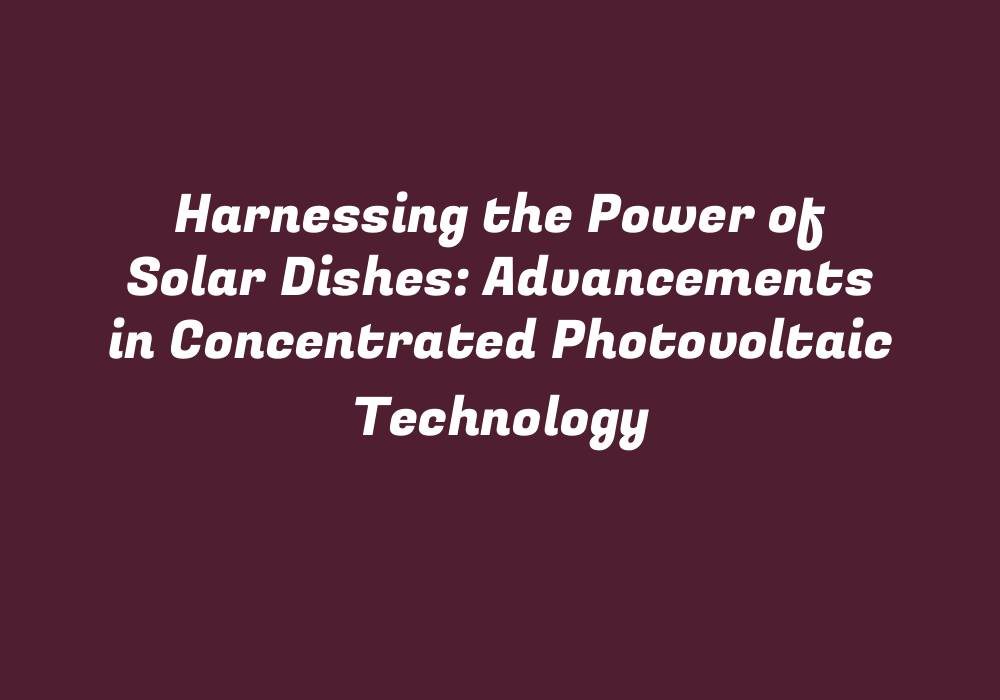Harnessing the Power of Solar Dishes: Advancements in Concentrated Photovoltaic Technology
In the quest for renewable energy sources, solar power has emerged as a viable alternative to fossil fuels. One of its key applications is concentrated photovoltaics (CPV), which utilize sun-tracking systems and light-reflecting surfaces, known as solar dishes, to concentrate sunlight onto photovoltaic cells. This innovative technology offers numerous benefits over traditional solar panels while improving overall energy efficiency.
The Evolution of Concentrated Photovoltaics
Concentrating photovoltaics originated in the 1980s as an advanced approach to harnessing sunlight’s power. The primary goal was to increase the amount of energy generated by solar cells while minimizing their size and cost. As technology improved, new designs emerged with various concentrator types, including Fresnel lenses, reflective troughs, and compound parabolic concentrators (CPCs).
Benefits of CPV Systems
CPV systems offer several advantages over traditional solar panel installations. Here are some key benefits to consider:
1. Higher Efficiency: Solar dishes focus sunlight onto a smaller area, leading to increased photovoltaic cell efficiency. This results in improved overall energy conversion rates and better utilization of available sunlight.
2. Cost-Effectiveness: CPV systems require fewer solar cells than conventional panels, resulting in lower materials costs. Additionally, the concentrated sunlight reduces the need for more substantial trackers and supporting structures, further reducing expenses.
3. Space Efficiency: The use of light concentrators significantly reduces the physical footprint of a system compared to traditional solar panels. This is particularly beneficial for urban areas with limited space or rooftops where land use is limited.
4. Modularity and Scalability: CPV systems can be easily adapted and scaled based on individual needs, enabling flexible power generation configurations across different locations and applications.
5. Increased Reliability: Due to their smaller size, solar dishes have fewer components than conventional solar panels. This leads to a lower failure rate and overall improved reliability of the system.
6. Enhanced Temperature Control: By using light concentrators, CPV systems can better manage heat dissipation during high-intensity sunlight exposure, ensuring consistent performance across various weather conditions.
Current Technological Advancements
Recent advancements in concentrated photovoltaics are transforming the field of solar energy, leading to improved efficiency and cost reduction while increasing sustainability efforts:
1. New Materials Development: Innovative materials are being used to manufacture more efficient solar cells that can withstand higher levels of light concentration and maintain their performance over time.
2. Advanced Optics: The development of sophisticated Fresnel lenses and reflective trough designs allows for increased sunlight capture while reducing losses due to absorption and reflection.
3. Enhanced Tracking Systems: Solar dish systems now offer greater accuracy in sun tracking, resulting in increased solar energy capture throughout the day. These systems can also be designed to follow the movement of the sun over different seasons and locations.
4. System Integration: CPV technology is being integrated with other renewable energy sources such as wind power or hydroelectricity to create hybrid systems that offer a more consistent output regardless of weather conditions.
5. Smart Control Systems: Advanced control algorithms are employed to optimize system performance, manage shading issues and mitigate thermal effects. These intelligent systems allow for better power management and improved operational efficiency.
Conclusion
Solar dishes, coupled with the advancements in concentrated photovoltaic technology, hold great potential to revolutionize the solar energy industry. With increased efficiency, lower costs, and enhanced reliability, CPV systems can effectively contribute to a more sustainable future while meeting our growing energy demands. As research continues to improve upon current innovations, we are closer than ever before to harnessing the full power of concentrated sunlight for a brighter, greener planet.
